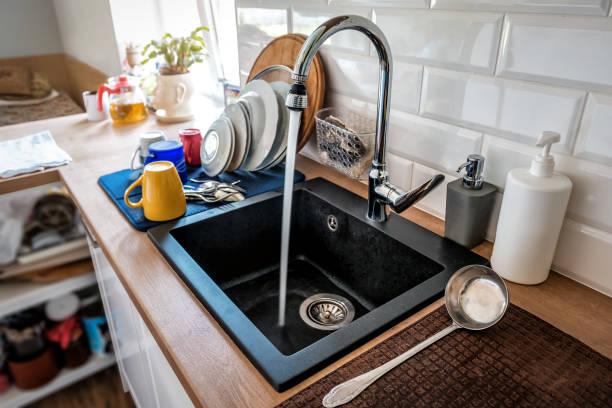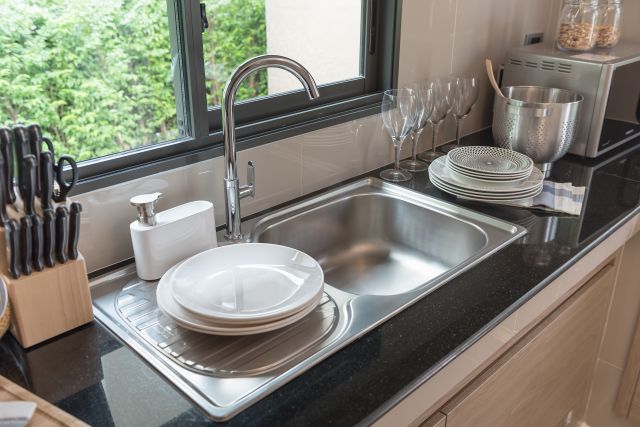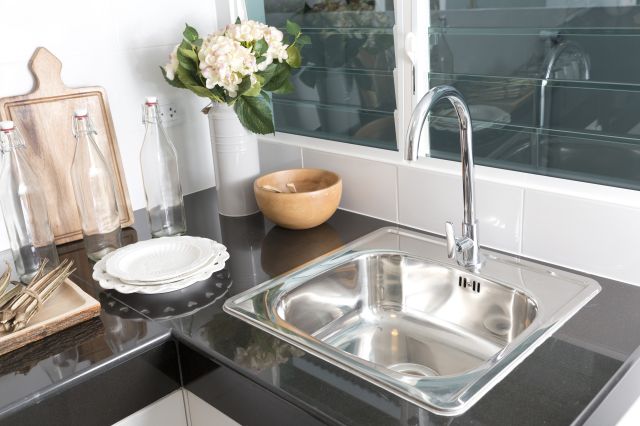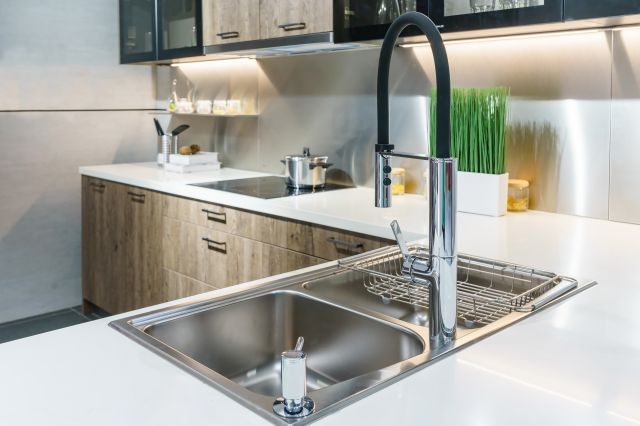Choosing the right size for your kitchen sink is crucial for both functionality and aesthetics. With various sink sizes and dimensions available, it’s essential to understand the standard of kitchen sink dimensions, sizes, and considerations to ensure a perfect sink fit.
In this article, we will explore the standard kitchen sink sizes in inches and provide valuable insights on how to select the ideal size for your kitchen. Let’s dive in!
What is the Standard Size for a Kitchen Sink in Inches
One of the most frequently asked questions regarding kitchen sink sizes revolves around what the standard kitchen sink size is. Generally, the standard sink size for a kitchen measures 22×30 inches. These dimensions apply to either a single-bowl sink or a double-bowl sink.
Nonetheless, the width for different types of sinks can vary. Single bowl sinks tend to have larger width dimensions of up to 33 inches. Conversely, double and triple bowl sinks models can go up to 48 inches. If you opt for a triple bowl or double sink one, you can find units with a width of even 60 inches.
In cases where you are dealing with narrow spaces, there are sinks measuring 8 to 14 inches front-to-back and can stretch up to 50 inches or more width-wise.

What is the Depth of Standard Kitchen Sinks?
Sink depth adds another dimension to choosing the right sink, quite literally. The common depth for standard kitchen sinks ranges between 8 to 10 inches. The depth you choose greatly influences both the utility and comfort of your new sink itself. An 8-inch depth is typically easier to work in, as it reduces the need to bend over or reach down, but a 10-inch depth allows more room for cleaning larger pots and pans.
What are the Dimensions of a Standard Kitchen Sink?
A standard kitchen sink, typically measuring 22 inches by 30 inches, can either feature a single or a double bowl. However, based on different kitchen designs and requirements, there are smaller kitchen sink sizes and larger ones.
| Dimensions of a Standard Kitchen Sink | Best for |
| 22-inch Sinks | compact kitchens as secondary sinks in larger kitchens |
| 24-inch Sinks | compact kitchens small kitchens |
| 30-inch Sinks | relatively compact kitchens standard kitchens |
| 33-inch Sinks | standard kitchens |
| 36-inch Sinks | large families and busy kitchens |
| 45-inch Sinks | professional or commercial kitchens |
22-inch Sinks
Making the most out of compact spaces, 22-inch sinks are the perfect fit for small kitchens or kitchenettes where counter space is at a premium. Even with its compact dimensions, a 22-inch sink doesn’t compromise functionality. It provides ample room for everyday kitchen tasks such as dishwashing, food prep, and cleanup.
With its minimal footprint, it leaves more counter space free for other kitchen activities, making it an ideal solution for homeowners with limited kitchen space or for those living alone or with a partner.
24-inch Sinks
Presenting an equilibrium between functionality and space efficiency, 24-inch sinks are considered the most common size sink you’ll find in many kitchens. This site provides a sufficient sink area for washing larger dishes, pots, and pans, while not overwhelming the counter space.
The versatility that 24-inch sinks offer makes them a sought-after choice for various kitchen layouts. It’s a size that caters well to most dishwashing and food preparation needs without encroaching on valuable counter real estate.
30-inch Sinks
Taking a step up the size ladder, we have the 30-inch sinks, an exemplar of stainless steel sinks with a spacious washing basin that facilitates various culinary activities. A particular favorite in larger kitchens that deal with extensive food preparation, these sinks offer a generous soaking space for larger pots and pans, thereby simplifying cleaning tasks.
With the 30-inch sink, you can prepare a multi-course dinner, host a family get-together, or even engage in baking projects, knowing well that your sink is spacious enough to handle the aftermath.

33-inch Sinks
The 33-inch sinks, slightly larger than their 30-inch counterparts, invite added convenience into your kitchen tasks. This size is particularly common for double-bowl sinks, providing more room for multitasking. The 33-inch size allows for easy separation of washing and rinsing duties, or prepping and cleaning tasks, enhancing your kitchen workflow during those peak culinary moments.
36-inch Sinks
Ascending further in the realm of kitchen sink sizes in inches, the 36-inch sinks bring along a charm of spaciousness. Custom-made for large families and busy kitchens, this generous new sink size can support multiple tasks simultaneously, such as washing dishes on one side and prepping foods on the other.
A 36-inch sink is more than just a kitchen fixture; it is a testament to extravagance, marrying practicality with stellar design aesthetics to furnish a luxurious kitchen centerpiece.
45-inch Sinks
At the pinnacle of large kitchen sink sizes in inches, you find the impressive 45-inch sinks. This substantial size is often associated with professional or commercial kitchens that demand considerable space for expansive food preparation and cleanup.
If you have a spacious kitchen that can effortlessly accommodate this magnitude, the 45-inch sink is a promise of limitless space for your kitchen tasks, allowing you to navigate through your culinary chores without ever worrying about running out of sink space.

What are Some Types of Kitchen Sinks?
Understanding kitchen sink types is as crucial as knowing the different kitchen sink sizes in inches. Various sink types include top-mount sinks or drop-in sinks, under-mount sinks, single-bowl sinks, and double-bowl sinks. Each particular sink also has its own unique features and advantages based on your specific kitchen needs.
Top Mount or Drop-In Sinks
Top mount sinks or drop-in sinks are the most common type of kitchen sinks due to their easy installation. The unique attribute of these sinks is the rim or lip that extends around the sink’s perimeter, resting directly on the countertop. This design not only supports the weight of the sink, but it also helps to seal the area around the under-mount sink, preventing water from seeping under the countertop.
Another advantage of these top-mount sinks or drop-in kitchen sinks is their versatility, as they are compatible with virtually any kind of countertop material, including laminate and tile, which are not suitable for under-mount sinks.

Undermount Sinks
Undermount sinks are installed under the countertop, offering a sleek look and easy clean-up benefits. Since there is no lip or rim sitting on top of the countertop, you can simply swipe food scraps or spills straight into the under-mount sink without hitting any roadblocks. This feature not only promotes cleanliness but also streamlines your kitchen chores.
Single Bowl Sinks
Single bowl sinks, equipped with one spacious basin, bring functionality with simplicity. This one single-bowl of sink style offers an abundance of space, making large and awkwardly-shaped dishes, pots, and pans easier to handle.
Furthermore, the extra depth of single bowl sinks also means less splashing on your clothes and countertops, keeping your kitchen cleaner. Their simplicity extends to installation as well—single bowl sinks are generally easier to install than their multiple basin counterparts, given fewer plumbing connections are usually required.
Double Bowl Sinks
Doubling up on functionality and convenience, double bowl sinks provide two separate basins, enabling you to multitask. Double bowl sinks can significantly enhance your kitchen workflow, making dishwashing and food preparation more efficient and the prep sink less messy.
While the installation of a deeper sink might be comparatively intricate due to the added drainage system, the benefits of optimized multitasking definitely tip the scale.

How Do I Measure My Kitchen Sink Size in Inches?
Width: Measure from the left outer edge to the right outer edge across the sink basin(s). This gives the width of your sink.
Length (or front-to-back): Measure from the back edge (closest to the wall or backsplash) to the front edge of the sink. This gives the length or depth from front to back of your sink.
Depth: Measure from the top edge of the sink where it meets the countertop (also known as the sink rim, or lip of the sink) straight down to the bottom of the sink basin. This provides the depth of your sink.
Optional: Measure the faucet holes: If you plan to install a faucet on your sink, measure the distance from the center of the leftmost faucet hole to the center of the rightmost faucet hole. This will give you the distance between the faucet holes.
What are the Important Factors to Consider While Choosing the Kitchen Sink Size?
When choosing the right kitchen sink (Learn: How to Choose from 10 of the Best Materials for Kitchen Sink) size, consider factors such as the available counter and cabinet space, the existing sink material and design, your family’s needs, and even your perfect sink height for comfort.
Kitchen Size
The size of your kitchen will significantly impact the size of the sink you can install. A small kitchen may not be able to afford the space required for a large sink.
Counter and Cabinet Size
The size and layout of your cabinets and countertops will directly determine the maximum size for your sink. There needs to be enough counter space for the sink and enough cabinet space underneath for installation.
alt: counter with basin
Sink Purpose
If your sink is primarily used for washing dishes by hand, a larger sink may be needed. If you mostly use a dishwasher and use the sink for food prep and small cleaning (Learn: How to Clean Corian Sink Without Effort) tasks, a smaller sink might be better.
Number of Bowls
The decision between a single bowl and a double (or even triple) bowl sink can affect the overall size of the sink.
Type of Installation
Certain sink installations, like under-mount or drop-in, may have specific size requirements or limitations.
Aesthetic Preference
The size of the sink can impact the aesthetic and design of your kitchen. You want to ensure that it fits well with the overall look and feel you are going for.
Your Budget
Larger sinks tend to be more expensive, so consider your budget when choosing your kitchen sink size.
Future Needs
Consider your new sink needs in the future. If you plan to sell the house or change the kitchen design, choose a new sink size that is universally appealing.
Can I Customize the Size of My Kitchen Sink—Getting Starting With KKR
In certain scenarios, you might not find a perfect match within the small or standard kitchen sink sizes. This is when customizing kitchen sink sizes in inches comes into play. With KKR, you can work together to create bespoke-inch sink solutions that accurately match your kitchen’s parameters and practical needs.
In conclusion, knowing the kitchen sink sizes in inches, the type of sink, and the kitchen space at hand can significantly influence your choices while upgrading an already existing sink, kitchen sink depth, or installing a new kitchen sink. This article aims to help you navigate through these pivotal choices and equip you to create the perfect new sink, for the kitchen of your dreams, marrying functionality and aesthetics harmoniously.



